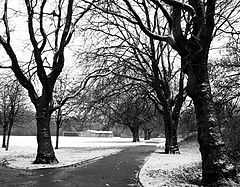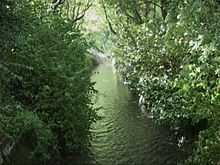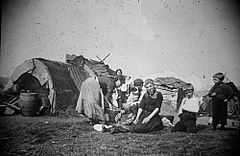Black Patch Park
Coordinates: 52°29′49″N 1°56′38″W / 52.497°N 1.944°W

Black Patch Park is a park in Smethwick, England. It is bounded by Foundry Lane, Woodburn Road, Perrott Street and Kitchener Street, at grid reference SP038888.
The park, covering over 20 acres (81,000 m2), was formerly part of a sparsely populated landscape of commons and woodland (known as The Black Patch), dotted with farms and cottages which has been transformed from heath to farmland then to a carefully laid out municipal park surrounded by engineering companies employing thousands of people; Tangyes, Nettlefolds, (later GKN plc), the Birmingham Railway Carriage and Wagon Company, Birmingham Aluminium Castings, ironworks, glassmaking and brewing. These factories, including the Soho Foundry, started by James Watt and Matthew Boulton are, but for foundations and frontages, almost all gone.[1]
Much of what is known about Black Patch Park appears in a book by Ted Rudge, developed from an Open University degree thesis, and published by Birmingham City Council in 2003. Rudge's research records how, from the mid-19th century until they were evicted from it at the start of the 20th, the 'Black Patch' was the camping ground of a community of tent and vardo (caravan) dwellers who were to become integrated with 'gaujos' (non-Gypsies) in surrounding districts. The Gypsies on the Black Patch lived on a deep barren layer of furnace waste, which, after their eviction, was cleared down to grass growing soil to create a park.[2]
Situation

Black Patch Park lies 2½ miles from Birmingham city centre just outside the boundary of the city, and is surrounded north, east and south by railway embankments. One of these carries the Birmingham - Wolverhampton part of West Coast main line. That and the A41 and the Birmingham Canal Navigations' Birmingham to Wolverhampton 'Mainline' canals - old and new - are arteries of the region's 'North West Corridor of Regeneration'.
In the centre of Black Patch Park, Boundary Brook, which for centuries marked a boundary between Staffordshire and Warwickshire, meets Hockley Brook, which once separated the country villages of Handsworth and Smethwick.[2] Boundary Brook enters from the South, while Hockley Brook comes in from the West under Woodburn Road.
The Park is linked to the Birmingham main line canal via a route through Avery Road that connects it to the West Midlands Sustrans Cycle Route 5, running along the canal towpath, part of a National Cycle Network running from the Cotswolds via Stratford-upon-Avon, Warwick, Birmingham, and Stafford to Stoke-on-Trent in Staffordshire.
Black Patch Park is edged by Foundry Lane to the west and south, Woodburn Road to the north, and Perrott Street and Kitchener Street to the east, beyond which, as far as Handsworth New Road, stretches the triangle of Merry Hill Allotment Gardens. The Midland Metro has a stop nearby.
Industrial Revolution

In 1769 James Brindley supervised the building of a canal between Birmingham and the Black Country. This waterway came to be known, within 60 years, as the 'old' Main Line Canal after Thomas Telford constructed a straighter, broader New Birmingham Main Line Canal, which opened in 1829 to carry an ever-increasing volume of narrow boat traffic. Brindley and Telford's waterways attracted industrial entrepreneurs including Matthew Boulton, and James Watt who bought 18 acres (73,000 m2) by the canal at Merry Hill, about a mile from the firm's Soho Manufactory in Handsworth and opened the Soho Foundry[3] in 1796 'for the purpose of casting everything relating to our steam engines'.
As the local population grew, tension developed between them and the travellers. Rudge[2] records that Gypsies and travellers camped on the "Black Patch" from the mid-19th century, not always with approval of local people. Only in the early 20th century, and after several attempts, were the Gypsies finally and forcibly evicted from the 'Black Patch' as rising population density and new land owning assumptions placed greater and greater restriction on their traditional sites.
From being a thriving industrial site, the area was transformed in little more than a lifetime, to a site of dereliction[citation needed], with the decline of almost all the park's surrounding industrial giants during the economic upheaval of the 1960s. One successful survivor is Avery Weigh-Tronix on Foundry Lane, the world's largest manufacturers of machines for weighing, counting, measuring and testing, whose main entrance is the frontage of Boulton's and Watt's old Soho Foundry opposite the 'Soho Foundry Tavern'.
Gypsy connection

In 1906 Mrs E J E Pilkington and Tangye Ltd were referred to as legal owners of Black Patch, having put it up for sale after employing land agents to carry out a court imposed eviction of the Gypsies on 26 July 1905. They did not finally relinquish links with the land until a "peaceful eviction" was negotiated by Birmingham Corporation Parks Department on 15 February 1909.[2] Subsequent stories contribute to reasonable doubt as to who ought to have inherited the Black Patch and who now holds legal title to the Gypsies' old camping ground. Rudge[2] reports that in 1960 Jane Badger, who lived near Black Patch, got into conversation while walking by the Park with a gentleman with an American accent. He claimed he owned the deeds to the land. This story resembles a statement made by Ray Plant,[2] a distant relative of the Black Patch Gypsies, that a family called Murdock once owned the land and gave permission to camp there. According to Ray Plant when the Murdocks emigrated to America they handed over the Black Patch deeds to the Gypsies. The deeds were apparently stolen making any of the gypsies claims to the land unfounded. Many of the gypsy descendants still live in the surrounding area. If you live in that area or have relatives that come from that area you can find very easily on the census.[2]
In July 2005, a memorial plaque to the gypsies was erected.[5] Sometime in March 2007 this plaque disappeared but has since been replaced.
Creating the Park
Despite past and present doubts [2] about exact ownership the impetus for and organisation of its purchase and development as a public park came from the Birmingham Playgrounds, Open Spaces and Playing Fields Society, chaired by John Nettlefold, a Birmingham Councillor, married into the Chamberlain family. A mix of public subscription and cash from Smethwick and Handsworth Councils and Birmingham Corporation raised £12,200.[2] One of the vendors, Mrs Pilkington, donated £500 from the conveyance to assist with their aim of providing a place where people could enjoy fresh air away from the smoky atmosphere of the surrounding factories. The new public space was divided into three; 6 acres (24,000 m2) in Handsworth, seven in Smethwick and seven in Birmingham. Further land was acquired to build Perrott Street, widen the Great Western Railway and provide the Merry Hill Allotments on the other side of Perrott Street. Birmingham Corporation was asked by the Society to lay out and manage Black Patch Park. Unemployed people under the supervision of a Parks' Superintendent carried out this work. It began in January 1909 and was completed in May 1910. The Lord Mayor of Birmingham, Alderman Bowater, formally opened the Black Patch Recreation Ground on 20 June 1911. In 1966 management was taken over by the new Borough of Warley, now Sandwell Metropolitan Council, whose Planning Department confirms that covenants held by Pilkington and Tangye still exist,[2] but until then Black Patch Park was under the stewardship of Birmingham Parks Department.
Campaign to save Black Patch Park

In August 2003 a campaigning group called "The Friends of Black Patch Park" [4] was formed to challenge proposals outlined in Sandwell Council's Unitary Development Plan to zone two thirds of the park for industrial use. The aim of the Friends of Black Patch Park has been to protect, celebrate and enhance the park's 20 acres (81,000 m2) - as originally created by public subscription in 1907 - as a place of historic importance and indispensable green space for future generations. As well as its legacy as a traditional Romany camping ground, the park's current value is as a wildlife oasis, a place for quiet walks and relaxation and an essential site for a large number of young people from diverse backgrounds to practice sport. Footballers from the Soho Foundry Tavern and many other Warley League Teams, are strongly against the loss of the playing fields that make up the largest part of the Black Patch.
Chaplin
In 2011, a letter, written to him in the 1970s, came to light, suggesting that comedian Charlie Chaplin had been born in a gypsy caravan at the park.[6]
Salvation
Agenda item 5 of a Report to the Cabinet Member for Regeneration and Transport, Councillor Bob Badham, Sandwell MBC, dated 21 February 2007, states:
Within the adopted Unitary Development Plan, sites around Black Patch Park, near to the Soho Foundry were allocated for industrial uses in order to attract investment for a Technology Park. However, this has not come to fruition. A recent Employment Land Survey has revealed that there is no immediate need for further industrial land in this location. As there are no deliverable proposals identified, and to accommodate the wishes of Friends of Black Patch Park to retain the Park area, these allocations have been removed. The land will therefore form a green focal point for any development which takes place on the adjoining sites. The Preferred Option for land adjacent to Soho Foundry has been allocated for Mixed Used which can incorporate industrial and offices, and possibly leisure, community and educational facilities associated to the Foundry once a suitable re-use has been identified. Smethwick Area Action Plan - Preferred Option Document (Cabinet Forward Plan Ref. No. RT089).
References
- ↑ Smethwick Local History Society
- ↑ 2.0 2.1 2.2 2.3 2.4 2.5 2.6 2.7 2.8 2.9 2.10 Ted Rudge Brumroamin: Birmingham and Midland Romany Gypsy and Traveller Culture. Birmingham City Council Department of Leisure & Community Services (2003)
- ↑ Avery Weigh-Tronix
- ↑ 4.0 4.1 Ted Rudge's web pages on a campaign to save Black Patch Park (including the full text of Bryn Phillips song)
- ↑ Ted Rudge's "Romany Memorial"
- ↑ http://www.expressandstar.com/news/2011/02/18/charlie-chaplin-was-born-into-midland-gipsy-family/
- David Papadopoulos (2002) Spatialities of Dereliction
- Sandwell UDP Position statement on 'Open Space' in Sandwell.
- Ted Rudge (2003) Brumroamin: Birmingham and Midland Romany Gypsy and Traveller Culture. Birmingham City Council Department of Leisure & Community Services (2003)
External links
- BBC on 'Brumroamin'
- Built Environment Cabinet member Cllr Bob Badham talks about Sandwell MBC's policies to save Black Patch Park
- Images to supplement this article
- Revolutionary Players. History of the Industrial Revolution in the West Midlands. See especially the images at to get an impression of how the Black Patch became named.
- Smethwick Local History Society
- Soho Foundry Soho Foundry
- Ted Rudge's 'Romany Memorial'[6]
- Ted Rudge's website on the campaign to save Black Patch Park (including the text of Bryn Phillips song)()
- The Smethwick Town Plan (PDF document). See section on the 'Foundry Lane Action Area' in paras 8.6.1 to 8.6.20, pp. 116–120 (map on page 120) and in Appendix 1, p. 128. As indicated at the conclusion of this article The Smethwick Town Plan is now under review, though any changes supported by Sandwell MBC must be approved by the Secretary of State under the terms of the Planning and Compulsory Purchase Act 2004